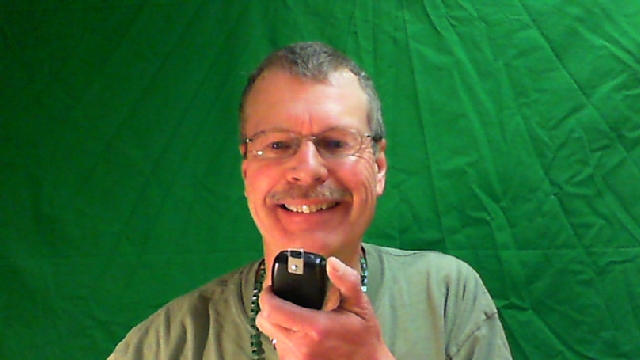Welcome to Handiham World!

Photo: Pat, WA0TDA, with microphone, sports a green T-shirt, green beads, and a green screen background for St. Patrick's Day. Hey, if Chicago can dye a river green, we can do this!
Happy St. Patrick's Day, everyone. This is the first time in my memory that the Irish holiday has fallen on the same day as our weekly newsletter and podcast, so why not just use it as an excuse for a fun way to start our weekly column?
I'm not sure if there are any special ham radio events associated with St. Patrick's Day, but I do know that there are plenty of parades and other civic events. St. Patrick's Day is always a big deal in cities like Boston, Massachusetts and St. Paul, Minnesota where there are historical Irish roots. Any time you have a parade or civic event there is an opportunity for amateur radio support in the form of communications. While I know of no amateur radio support for parade activities during today's activities here in the Twin Cities, amateur radio volunteers do support plenty of other worthwhile civic events. Marathons, bicycle races, walkathons, and other types of parades or large events that cover considerable territory are all candidates for amateur radio communications support.
These types of activities are similar in many ways to the volunteer work that amateur radio operators do in emergencies. However, there is a difference in that many of the communications in an event are much more routine and may be structured in a more informal way than communications in an emergency where a command structure is set up under very specific guidelines. In a public service event, which is what these non-emergency activities are called, your radio club may decide to participate as a group and call for volunteers. It always helps when public service communicators have some training and experience, but public service communication may be a less demanding place to get started than in emergency communications. It all depends on the event and the person in charge of communications. Some events are so large and complicated or cover so much territory or have potential for generating emergency response-style situations that they may be looking for volunteers who are more familiar with a structured incident command system. On the other hand, some events are more easily managed with semi-formal organization and communication. While good operating practice is essential for either, you may want to get your feet wet by helping with communications at one of these smaller events in the realm of public service.
Good communications basics will include knowing how to identify your station, including identification by location if that is the most efficient way to identify and it is what your group has agreed to do. This is called a tactical identification. Of course you do still have to use your FCC-issued callsign periodically as specified by Part 97 rules. A tactical identification might be something like "rest stop five". At the end of a series of transmissions and every 10 minutes you do have to use your regular callsign. There are many other things to learn about public service communications that will help you learn "on the job" as you gain experience and work toward being a capable volunteer in ARES, able to handle more demanding formal communications within an incident command structure.
In many ways, amateur radio is like other learning activities. If you were to have to learn calculus or how to speak Chinese, you would not begin with differential equations or interpretation of ancient Chinese texts. You would instead choose to begin at, well, the beginning! You would start with simple concepts and easy tasks, practicing and learning incrementally, gaining knowledge every time you study or practice. Amateur radio is a huge and complicated activity when you consider all of the different licensing classes, the many different types of technology, multiple modes of operation, and extraordinary array of on the air activities. No one expects you to get your first license and be able to do everything -- and that goes for being a public service communicator. You need to start at the beginning, perhaps volunteering at an event like a St. Patrick's Day parade. Don't forget to wear green, and a reflective vest if you are on the parade route.
For Handiham World, I'm...
Patrick Tice, wa0tda@arrl.net